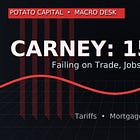🤖 The AI-Chip Tithe
Pricing a 15% U.S. rake on China-bound silicon (NVDA/AMD)
🔑 Executive summary
Washington’s new export-license framework effectively prices access to China for select U.S. AI accelerators: vendors can ship compliant parts if ~15% of the related China revenue is remitted to the U.S. government.
For modeling, treat it as a revenue-based levy with three key swing factors:
China revenue mix s;
pass-through p;
and product-mix migration toward compliant SKUs that preserve unit economics.
Decision-rule: with a 55% net margin and 5–10% China mix, no pass-through implies a ~1.4–2.7% EPS drag; 50% pass-through halves it.
Equity effects are second-order: the rule reduces “free” China optionality (less upside if restrictions loosen) but also disciplines discounting (less reason to underprice to win share). Position for pricing power + diversified demand, avoid models reliant on margin-thin China SKUs.
🚨 What changed - and why it matters
From prohibition to price:
The license structure converts binary export controls into a priced gate (≈15% of China-derived revenue for covered chips).
That makes regulatory risk analyzable: a toll you can try to pass through rather than an on/off switch.
Exposure reality:
China’s share of revenue for U.S. AI leaders fell post-controls; current mix is low- to mid-single-digits for some, higher for others, and volatile at the product level.
The right way to underwrite this is bands not points (e.g., 5–20% by company/product family).
Accounting note:
The levy is economically top-line. Depending on disclosure, it may appear as contra-revenue or COGS/other expense; in either case it drags operating and net margin unless passed through.
📐 Sensitivity math
s = China revenue share of total (5–20%)
τ = license rake on China revenue (15%)
p = pass-through rate to customers (0–100%)
NIM = net income margin (NVDA ~50–55%; AMD ~12–18% as order-of-magnitude)
Illustrations:
Interpretation: pricing power (high p) and mix management (lower s, higher NIM) dominate outcome.
📊 How the tape will actually price it
Gross-margin optics & anchors:
If the levy isn’t passed through, reported GM/OM step down on exposed SKUs, tightening the acceptable multiple range until visibility improves.
Competitive offsetting:
If domestic China accelerators avoid the rake onshore, U.S. vendors will lean on software attach, service SLAs, and financing bundles to keep per-unit economics whole.
Policy spillover risk:
A successful toll here normalizes priced access for other dual-use stacks (EUV subsystems, model weights, advanced packaging). The market will add a toll-probability premium to those value chains.
Elasticity trap:
China demand at the high end can be less price-elastic during supply scarcity but becomes more elastic once local alternatives clear the “good-enough” bar; that convexity matters to pass-through.
💰 Valuation mapping: earnings drag → multiple math
If EPS falls by fraction d from the rake, the multiple that keeps price unchanged satisfies:
Examples (directional):
d=1.4% → hold-price multiple +1.4%.
d=2.7% → hold-price multiple +2.8%.
When sentiment is fragile, the market won’t grant that offset - small EPS drags can translate into outsized price moves unless accompanied by stronger ex-China beats.
❗ What we’re watching (quant-lens)
Pass-through evidence: price cards and realized GM% by product family vs. pre-levy cohorts.
Mix migration: share of shipments into compliant SKUs (e.g., H20-class and successors) and any tiering to protect blended margins.
License cadence: scope creep (rate >15%, product expansion), processing frictions, or renewed pauses on specific SKUs.
Elasticity signals: China unit run-rates vs. license-adjusted price deltas; watch for unit drops exceeding the implied toll impact.
Substitution: pace/quality of domestic accelerator deployments and software portability away from CUDA-centric stacks.
💡 Playbook (positioning & risk controls)
Core long bias
Own pricing power: vendors with software monetization, ecosystem lock-in, and non-China demand depth that can pass through the toll without unit loss.
Mispriced fear: low-China-mix suppliers/partners getting painted with the same brush; re-rate as pass-through evidence accumulates.
Pairs / hedges
Long global AI infra bottlenecks (power, advanced packaging, networking backbones)
Short baskets where China pass-through proves weak or where compliant-SKU mix materially dilutes GM.
Kill switches
Unit elasticity in China turns materially negative (unit drop > toll-adjusted price delta).
Scope escalation (rate above 15% or expansion to higher-value SKUs) without offsetting mix.
Evidence that domestic China accelerators hit “good-enough” at scale with sticky software workflows - shrinks pass-through headroom.
📝 Implementation notes
Treat the rake as contra-revenue for decision analytics; reconcile later to disclosure.
Run a 3-input grid (s, p, NIM) and propagate to EBIT/EPS; tie to your segment-level P&L to watch GM/OM bridges.
Use a shadow China elasticity parameter to haircut pass-through at the SKU level.
Track a “toll probability” for adjacent dual-use stacks to price spillover risk premia.
🥔 Final Take
It’s a toll, not a ban.
Materiality scales with margin and China mix: small for high-margin, low-China names (NVDA-like), larger for thin-margin, higher-mix names (AMD-like).
Own pricing power + software attach; avoid reliance on margin-thin China SKUs.
Trade the math: verify pass-through and mix, fade de-rates when modeled EPS drag is de minimis (≈2–3%), and step aside if elasticity turns negative or the toll scope widens.
Sources: AP News; MarketWatch; Barron’s; Federal Register; Skadden; Yahoo Finance; BizTech Weekly; Tech Monitor.






